Linksys NAS200 Owner's Manual
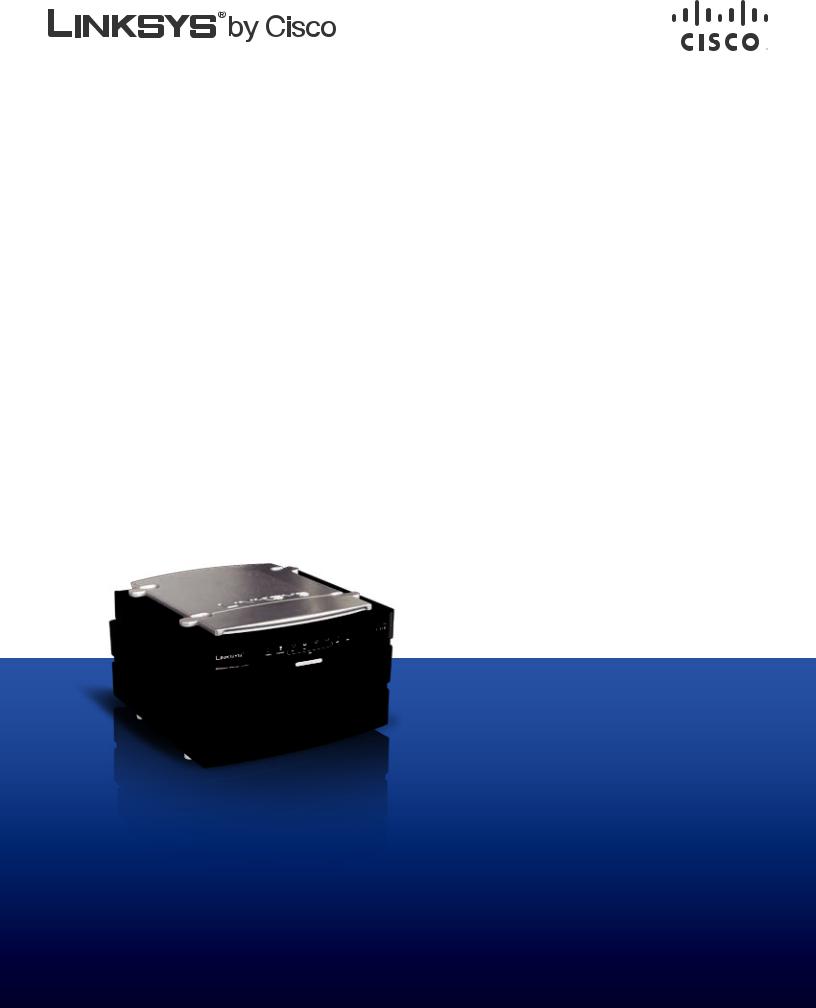
USER GUIDE
Network Storage System
with 2 Bays
Model: NAS200 (EU)
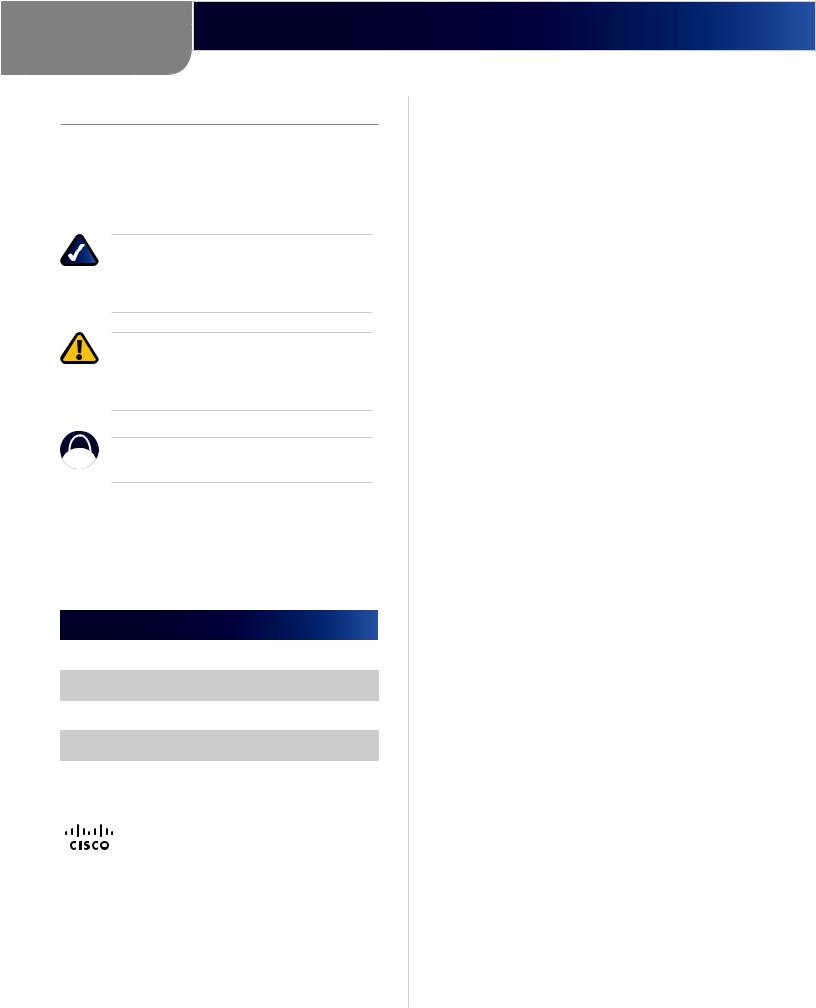
About This Guide
About This Guide
Icon Descriptions
While reading through the User Guide you may see various icons that call attention to specific items. Below is a description of these icons:
NOTE: This check mark indicates that there is a note of interest and is something that you should pay special attention to while using the product.
WARNING: This exclamation point indicates that there is a caution or warning and it is something that could damage your property or product.
WEB: This globe icon indicates a noteworthy website address or e-mail address.
Online Resources
Website addresses in this document are listed without http:// in front of the address because most current web browsers do not require it. If you use an older web browser, you may have to add http:// in front of the web address.
Resource |
Website |
|
|
Linksys |
www.linksys.com |
|
|
Linksys International |
www.linksys.com/international |
|
|
Glossary |
www.linksys.com/glossary |
|
|
Network Security |
www.linksys.com/security |
|
|
Copyright and Trademarks
Linksys, Cisco and the Cisco Logo are registered trademarks or trademarks of Cisco Systems, Inc. and/or its affiliates in the U.S. and certain other countries. Copyright © 2008 Cisco Systems, Inc. All rights reserved. Other brands and product names are trademarks or registered trademarks of their respective holders.
Network Storage System with 2 Bays |
i |

Table of Contents
Chapter 1: Product Overview |
|
|
|
|
1 |
Front Panel |
|
|
|
|
1 |
Back Panel . . . . . . . . . . . . . . . . . . |
. . . . |
. . . . . . |
. . . . |
. |
. 1 |
Drive Bay Doors |
|
|
|
|
2 |
Notification Sounds . . . . . . . . . . . . . . |
. . . . |
. . . . . . |
. . . . |
. |
. 2 |
Chapter 2: Configuration Using the Setup Wizard |
|
|
|
|
3 |
How to Access the Setup Wizard . . . . . . . . . |
. . . . |
. . . . . . |
. . . . |
. |
3 |
Set up Computer |
|
|
|
|
3 |
Set up Second Drive |
|
|
|
|
4 |
Backup Software . . . . . . . . . . . . . . . . |
. . . . |
. . . . . . |
. . . . |
. |
7 |
Advanced Setup . . . . . . . . . . . . . . . . |
. . . . |
. . . . . . |
. . . . |
. |
9 |
Install Utility |
|
|
|
|
9 |
Chapter 3: Advanced Configuration |
|
|
|
11 |
|
How to Access the Web-Based Utility . . . . . . . |
. . . . |
. . . . . . |
. . . . |
. |
11 |
Home . . . . . . . . . . . . . . . . . . . . |
. . . . |
. . . . . . |
. . . . |
. |
11 |
My Files > Files . . . . . . . . . . . . . . . . |
. . . . |
. . . . . . |
. . . . |
. |
11 |
My Files > My Downloads . . . . . . . . . . . . |
. . . . |
. . . . . . |
. . . . |
.12 |
|
My Files > Personal Info |
|
|
|
|
13 |
Administration > Status . . . . . . . . . . . . |
. . . . |
. . . . . . |
. . . . |
. |
13 |
Administration > Users . . . . . . . . . . . . . |
. . . . |
. . . . . . |
. . . . |
. |
14 |
Administration > Shared Folders |
|
|
|
|
16 |
Administration > System Options . . . . . . . . |
. . . . |
. . . . . . |
. . . . |
. |
17 |
E-Mail Alert . . . . . . . . . . . . . . . . . . |
. . . . |
. . . . . . |
. . . . |
.19 |
|
Firmware Upgrade |
|
|
|
|
20 |
Media Server . . . . . . . . . . . . . . . . . |
. . . . |
. . . . . . |
. . . . |
. |
21 |
Disk Utility . . . . . . . . . . . . . . . . . . |
. . . . |
. . . . . . |
. . . . |
. |
22 |
Disk Configuration |
|
|
|
|
24 |
Chapter 4: Use |
|
|
|
26 |
|
Access to the Network Storage System |
|
|
|
|
26 |
How to Access the Network Storage System . . . . |
. . . . |
. . . . . . |
. . . . |
.26 |
|
USB Storage Devices . . . . . . . . . . . . . . |
. . . . |
. . . . . . |
. . . . |
.28 |
|
How to Use the Network Drive Mapping Utility . . |
. . . . |
. . . . . . |
. . . . |
. |
29 |
Appendix A: Troubleshooting |
|
|
|
31 |
|
Appendix B: Specifications |
|
|
|
33 |
|
Appendix C: Warranty Information |
|
|
|
34 |
|
Limited Warranty |
|
|
|
|
34 |
Appendix D: Regulatory Information |
|
|
|
36 |
|
FCC Statement . . . . . . . . . . . . . . . . |
. . . . |
. . . . . . |
. . . . |
. |
36 |
Safety Notices |
|
|
|
|
36 |
Network Storage System with 2 Bays |
ii |

Table of Contents
Industry Canada Statement . . . . . . . . . . . . . . . . . . . . . . . . |
. . |
36 |
EC Declaration of Conformity (Europe) . . . . . . . . . . . . . . . . . . . . |
. |
36 |
User Information for Consumer Products Covered by EU Directive 2002/96/EC on Waste |
||
Electric and Electronic Equipment (WEEE) |
|
37 |
Appendix E: Software License Agreement |
|
41 |
Software in Linksys Products . . . . . . . . . . . . . . . . . . . . . . . . |
. |
41 |
Software Licenses . . . . . . . . . . . . . . . . . . . . . . . . . . . . |
. . |
41 |
Network Storage System with 2 Bays |
iii |
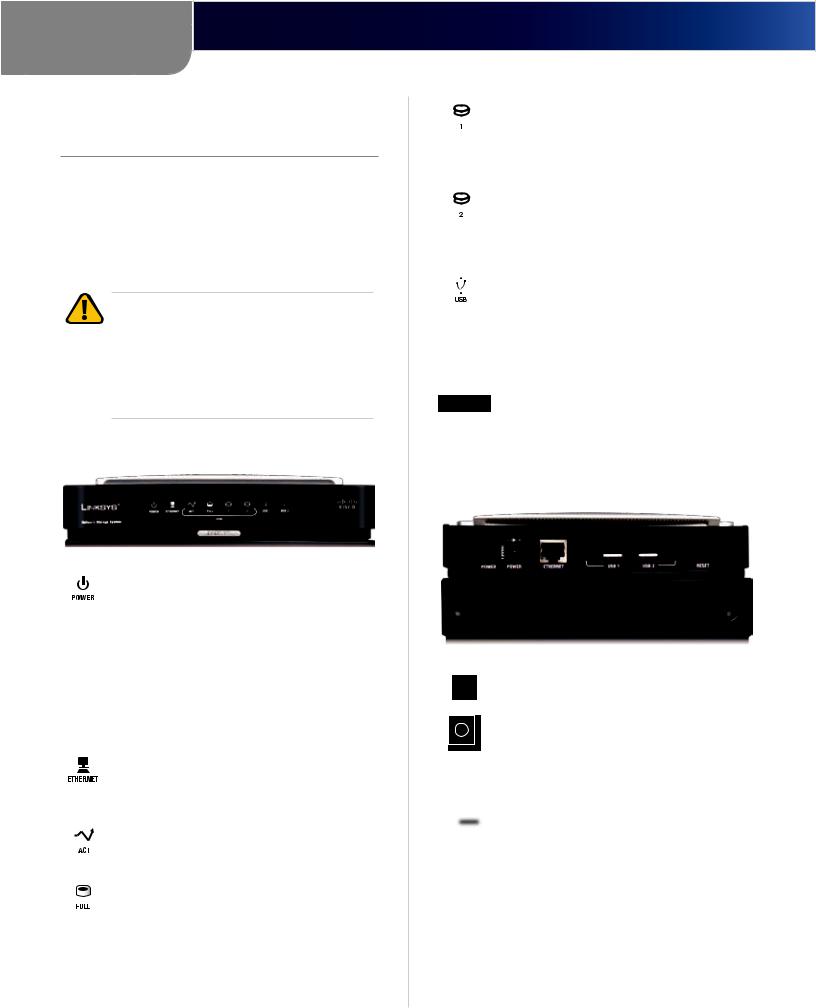
Chapter 1
Product Overview
Chapter 1:
Product Overview
Thank you for choosing the Linksys Network Storage System with 2 Bays. It features two SATA hard drive bays so you can add storage space to your network. There are also two USB ports that let you add USB hard drives for additional storage space, or you can connect a USB flash disk to access your portable files. (USB hard drives may require external power supplies.)
WARNING: Do not block the air vents, and do not stack devices on top of the Network Storage System; otherwise, overheating can occur.
(Air vents are located on the sides of the Network Storage System. Keep the area around the Network Storage System clear.)
Front Panel
POWER (Green/Orange) The POWER LED serves multiple purposes. It flashes green when the Network Storage System boots up, shuts down, prepares a disk, or scans a disk. The LED flashes green and orange when the Network Storage System upgrades its firmware. It is continuously lit green when the Network Storage System is ready for use. The LED is continuously lit orange when there is an error.
(See “Appendix A: Troubleshooting” for more information.)
ETHERNET (Green) The ETHERNET LED serves two purposes. The LED is continuously lit when a device is connected through the Ethernet port. It flashes to indicate network activity.
DISK ACT (Green) The DISK ACT LED flashes when the Network Storage System is accessing data on the disk.
DISK FULL (Green) The DISK FULL LED flashes when available disk capacity is less than 2% of total capacity or lower than the number you set through the web-based utility.
DISK 1 (Green) The DISK 1 LED serves two purposes. The LED is continuously lit when the hard drive in the top bay is ready for use. It flashes when the hard drive is reformatting or rebuilding with Disk 2 (RAID 1 mode).
DISK 2 (Green) The DISK 2 LED serves two purposes. The LED is continuously lit when the hard drive in the bottom bay is ready for use. It flashes when the hard drive is reformatting or rebuilding with Disk 1 (RAID 1 mode).
USB 1-2 (Green) The USB LED serves multiple purposes. The LED is continuously lit when the USB device is connected through the corresponding port. It flashes when the Network Storage System is accessing the USB device. After the LED powers off, the USB device can be removed.
 Back Up Button Press the Back Up button to initiate backup jobs specified by the backup software on your computer. (Your computer must be powered on for the jobs to run.)
Back Up Button Press the Back Up button to initiate backup jobs specified by the backup software on your computer. (Your computer must be powered on for the jobs to run.)
Back Panel
POWER Button Push the POWER button to power on or off the Network Storage System.
POWER The POWER port connects to the included power adapter.
ETHERNET The ETHERNET port connects to an Ethernet network device, such as a router or switch.
USB 1 The USB 1 port connects to your USB storage device. Press the USB 1 button to eject the device from the USB 1 port. After the Network Storage System beeps once and the USB 1 LED powers off, you can remove the device.
Network Storage System with 2 Bays |
1 |

Chapter 1
Product Overview
USB 2 The USB 2 port connects to your second USB storage device. Press the USB 2 button to eject the device from the USB 2 port. After the Network Storage System beeps once and the USB 2 LED powers off, you can remove the device.
RESET The RESET button has two functions:
•• To reset the network settings, such as the IP address, of the Network Storage System, press and hold this button for two seconds. The Network Storage System resets to DHCP and tries to get an IP address from the DHCP server on your network. If there is no DHCP server on your network, the Network Storage System will be set to its default IP address, 169.254.xx.xx (the x’s represent randomly generated
numbers). The Network Storage System beeps once to indicate that the reset has occurred.
•• To reset the password of the Network Storage System to its default value of admin, press and hold this button for 10 seconds. The Network Storage
System beeps twice to indicate that the reset has occurred.
Drive Bay Doors
The drive bay door covers the opening of the drive bay, which holds the hard drive. Push together the clips to remove the drive bay door. Disk 1 is inserted into the upper bay, and Disk 2 is inserted into the lower bay.
Notification Sounds
The Network Storage System emits sounds to indicate different activities or status information.
|
Notification Sounds |
|
|
|
|
Sound |
Meaning |
|
|
|
|
|
Power or Reset button pushed |
|
1 beep |
|
|
|
USB device ready to be removed |
|
|
|
|
2 beeps |
Reset button pushed and held for over |
|
10 seconds |
||
|
||
|
|
|
3 beeps every |
Available disk capacity is less than 2% |
|
15 seconds for 3 |
of total capacity or the number you set |
|
minutes |
through the web based utility (2 or 5 GB) |
|
|
|
Network Storage System with 2 Bays |
2 |
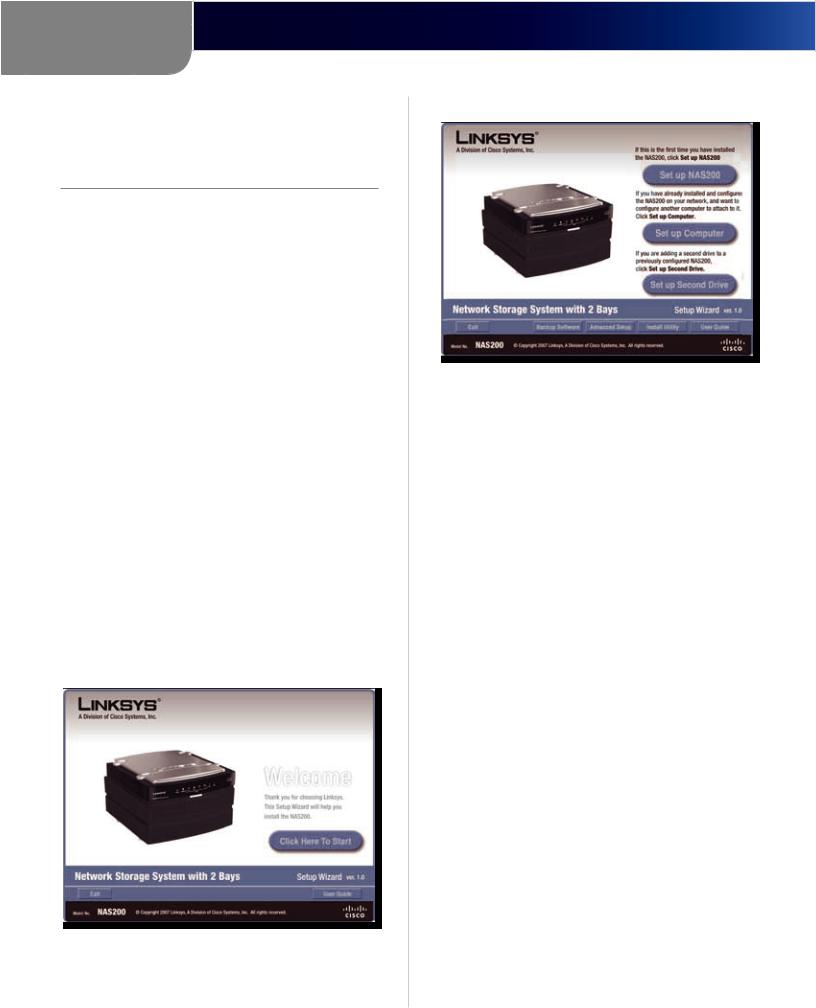
Chapter 2
Configuration Using the Setup Wizard
Chapter 2:
Configuration Using the
Setup Wizard
After first-time installation of the Network Storage System with the Setup Wizard (located on the CD-ROM), the Network Storage System is ready for use. However, additional configuration is available with the Setup Wizard and web-based utility.
Use the Setup Wizard for the following tasks:
•• Configure another computer to use the Network Storage System
•• Add a second hard drive to the already configured Network Storage System
•• Install backup software on your computer
•• Access the web-based utility
•• Install the Linksys Network Drive Mapping Utility
•• Access the User Guide on the CD
Use the web-based utility for advanced configuration (refer to “Chapter 3: Advanced Configuration” for details).
How to Access the Setup Wizard
1.Insert the SetupWizard CD-ROM into your PC’s CD ROM drive. The Setup Wizard should run automatically, and the Welcome screen should appear. If it does not, click Start and then Run. In the field provided, enter D:\SetupUtility.exe (if“D”is the letter of your CD-ROM drive).
2.Click the Click Here to Start button.
Welcome Screen
3. You have multiple options on this screen:
Welcome Screen with Options
––Set up NAS200 Install the Network Storage System for the first time. (The instructions are covered in the Quick Installation.)
––Set up Computer Configure another computer to use the Network Storage System.
––Set up Second Drive Add a second hard drive to the already configured Network Storage System.
––Exit Use this option to close the Setup Wizard.
––Backup Software Install a third-party program to run backup jobs.
––Advanced Setup Use this option to access the web-based utility.
––InstallUtility Use this option to install the Network Drive Mapping Utility.
––User Guide Use this option to open the pdf of this User Guide.
Set up Computer
Follow these instructions to configure another computer to use the Network Storage System.
1. Click Set up Computer.
Network Storage System with 2 Bays |
3 |
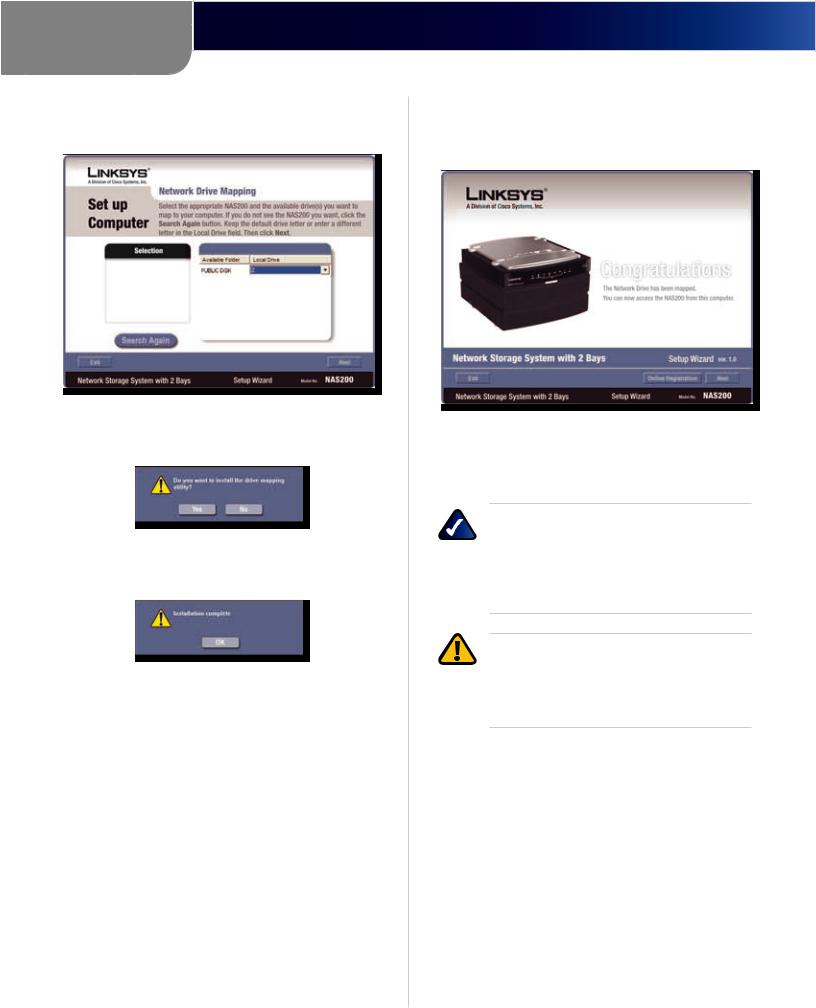
Chapter 2
Configuration Using the Setup Wizard
2.For the public folder, keep the default drive letter, or select a different letter from the drop-down menu. Click Next.
Map Network Drive
3.To install the Linksys Network Drive Mapping Utility on your computer, click Yes.
Install Drive Mapping Utility
4.The Setup Wizard automatically installs the utility. Click OK.
Drive Mapping Utility Installed
5.The network drive(s) are mapped to your computer.
Click Exit to exit the Setup Wizard, or click Next to return to the Welcome screen.
Network Drive Mapped
The computer has been configured.
Set up Second Drive
NOTE: Make |
sure your second hard drive |
|
is |
a 3.5-inch, |
Serial-ATA (SATA) hard drive. |
If |
you plan |
to stripe (RAID 0) or mirror |
(RAID 1) your drives, then match the drive sizes for maximum drive use.
WARNING: Low-profile or half-height hard drives can be used at your own risk; however, Linksys does not support the use of these drives as they are not securely held in place inside the Network Storage System.
Follow the instructions to add a second hard drive to your previously configured Network Storage System. If you physically install a second drive without running the Setup Wizard, then the second drive will not be formatted. It will have to be manually formatted using the web-based utility (refer to “Chapter 3: Advanced Configuration”).
Network Storage System with 2 Bays |
4 |
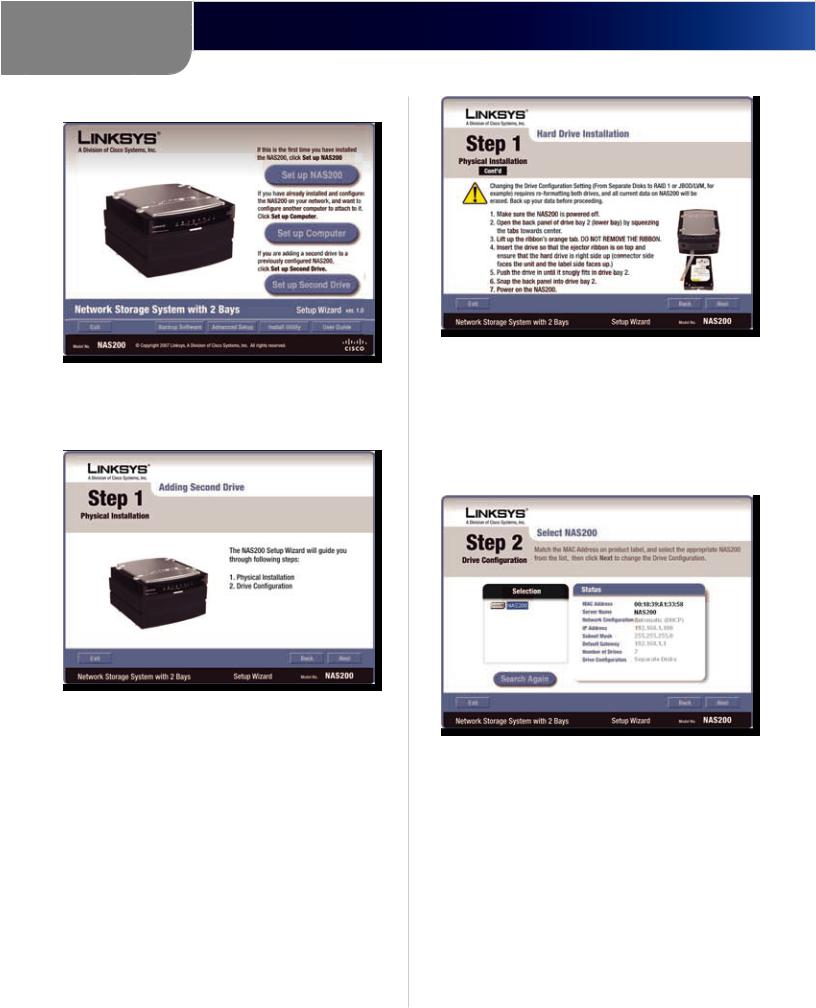
Chapter 2
Configuration Using the Setup Wizard
1. Click Set up Second Drive.
Set up Second Drive
2.The Setup Wizard explains that these instructions cover the physical installation and drive configuration. Click Next.
Overview
3.To install the second hard drive:
a.Power off the Network Storage System.
b.Push together the clips, and remove the lower drive bay door.
c.Lift up the ribbon.
d.Make sure the connector side of the drive faces the bay, and the label side faces up.
e.Make sure the drive is inserted under the ribbon. Push the drive in until it snugly fits in the bay.
f.Replace the drive bay door.
g.Wait until you hear the Network Storage System beep twice. Then click Next.
Physical Installation of the Second Hard Drive
4.The Setup Wizard automatically searches for any Network Storage System on your network. If it is not detected, check its cable connections, and make sure it is powered on. Click Search Again to locate the Network Storage System.
Select the appropriate Network Storage System. Click
Next.
Network Storage System Detected
Network Storage System with 2 Bays |
5 |

Chapter 2
Configuration Using the Setup Wizard
5.Select the appropriate configuration for your drive usage:
NOTE: If you change the drive configuration setting (for example, from Separate Disks to RAID 1), both drives will be reformatted and all current data will be erased. Back up any preexisting data before reconfiguring your drives.
––Maximum Storage - Separate Disks Drives seen separately.
––Maximum Storage - Multiple Disks (JBOD/LVM) Drives seen as a single virtual drive.
––Maximum Security - Mirroring (RAID 1) Requires two hard drives.
––Maximum Speed - Striping (RAID 0) Requires two hard drives.
Click Next.
Select Drive Configuration
6.Review the new settings. If they are correct, click Save. If you would like to change them, click Back to return to the previous screen.
Confirm New Settings
7.To confirm that you want to format your drives and erase all data on them, click Next.
WARNING: Before you format drive(s), back up pre-existing data because all data on your drive(s) will be erased when they are formatted.
If the drives have been previously formatted by the Network Storage System, click Skip to continue without reformatting.
Confirm Formatting
Network Storage System with 2 Bays |
6 |
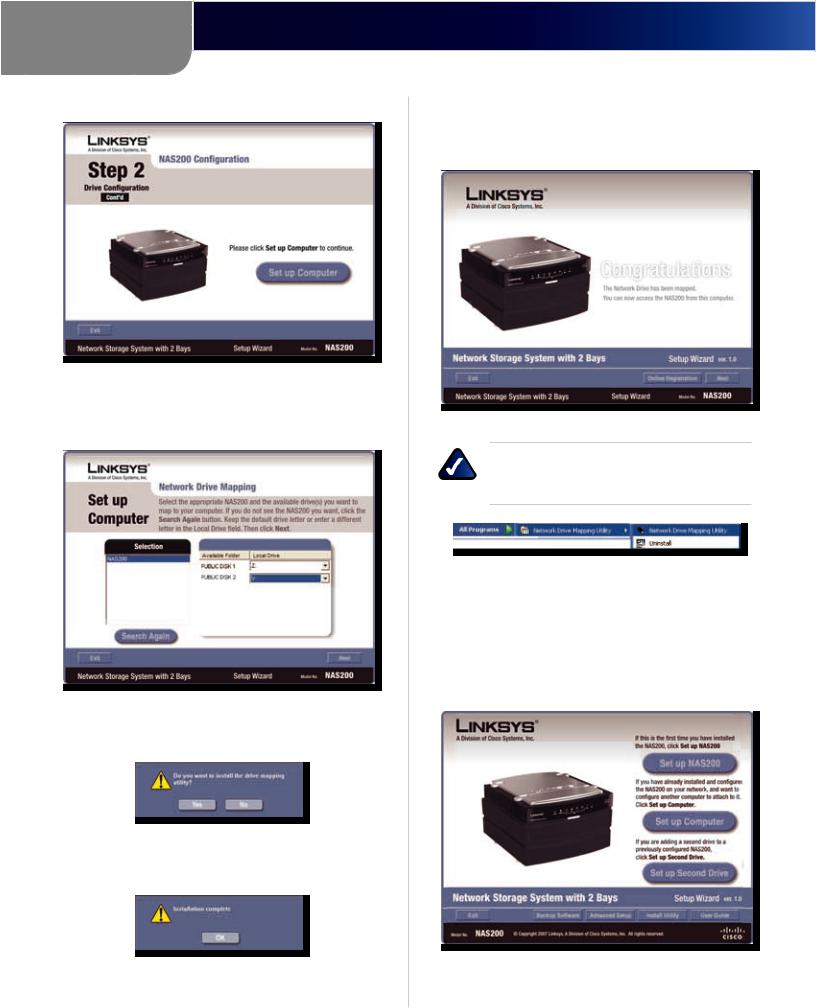
Chapter 2
Configuration Using the Setup Wizard
8. Click Set up Computer.
Set up Computer
9.For the public folder of the second hard drive, keep the default drive letter, or select a different letter from the drop-down menu. Click Next.
Map Network Drive
10.To install the Linksys Network Drive Mapping Utility on your computer, click Yes.
Install Drive Mapping Utility
11.The Setup Wizard automatically installs the utility. Click OK.
Drive Mapping Utility Installed
12.The network drive(s) are mapped to your computer.
Click Exit to exit the Setup Wizard, or click Next to return to the Welcome screen.
Network Drive Mapped
NOTE: If the utility is already installed on your computer(youcanseeitinyourlistofprograms), the Setup Wizard will skip the installation.
Program Folder
The second hard drive has been installed.
Backup Software
Follow these instructions to install a third-party program to run backup jobs.
1. Click Backup Software.
Backup Software
Network Storage System with 2 Bays |
7 |
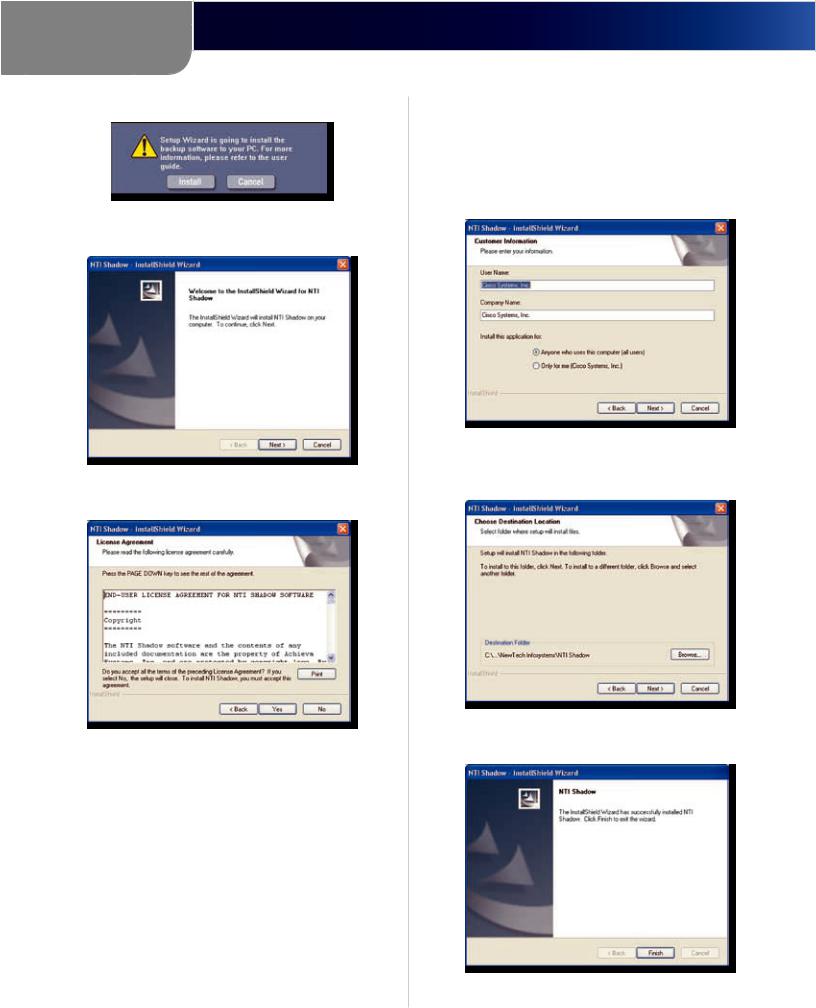
Chapter 2
Configuration Using the Setup Wizard
2. Click Install.
Install Backup Software
3. The InstallShield Wizard appears. Click Next.
Begin Installation of Backup Software
4. To accept the license agreement, click Yes.
License Agreement
5.Enter your information in the User Name and Company Name fields. Then select the users of the backup software:
•• Anyone who uses this computer (all users)
•• Only for me
Click Next.
User Information
6.Keep the default installation folder, or click Browse to select a different folder. Click Next.
Choose Destination Location
7. The backup software is installed. Click Finish.
Backup Software Installed
Network Storage System with 2 Bays |
8 |
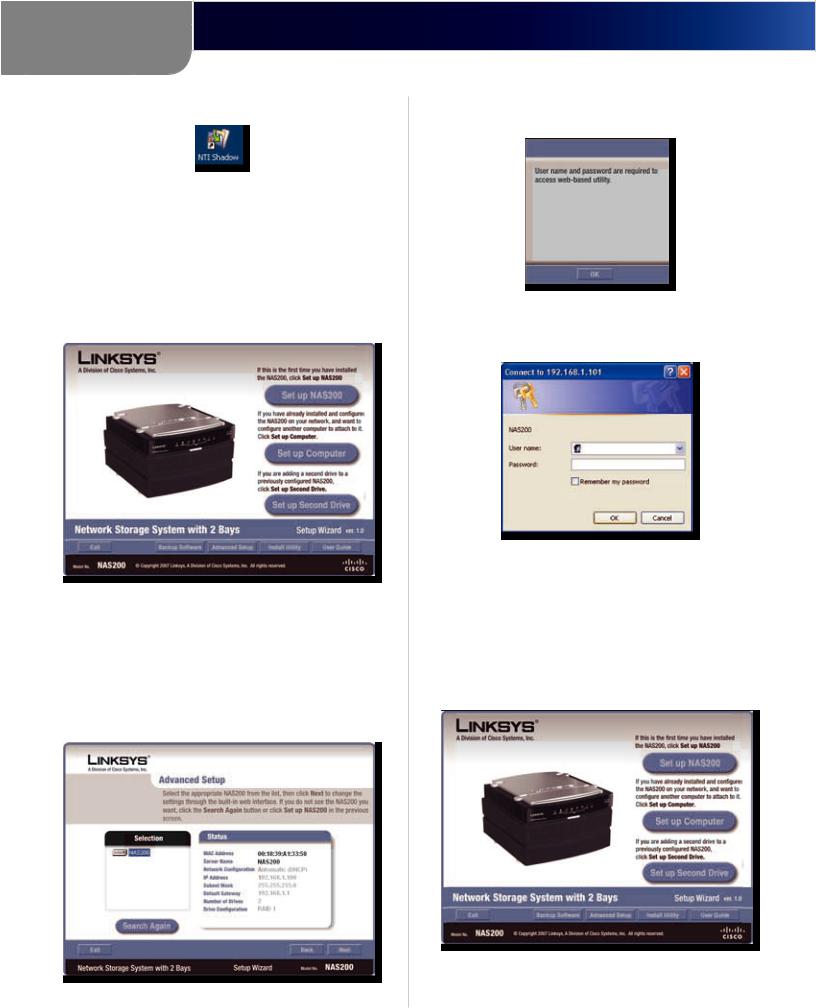
Chapter 2
Configuration Using the Setup Wizard
Double-click the desktop icon to access the software.
Desktop Icon for Backup Software
For more information, click Help on the main menu of the backup software.
Advanced Setup
Follow the instructions to access the web-based utility through the Setup Wizard.
1. Click Advanced Setup.
Advanced Setup
2.The Setup Wizard automatically searches for any Network Storage System on your network. If it is not detected, check its cable connections, and make sure it is powered on. Click Search Again to locate the Network Storage System.
Select the appropriate Network Storage System. Click
Next.
Network Storage System Detected
Network Storage System with 2 Bays
3.The Setup Wizard notifies you that a user name and password are required for access. Click OK.
User Name and Password Required
4.Enter your information in the User Name and Password fields. Click OK.
Login Screen
Refer to “Chapter 3: Advanced Configuration” for details about the web-based utility.
Install Utility
Follow these instructions to install the Network Drive Mapping Utility.
1. Click Install Utility.
Install Utility
9
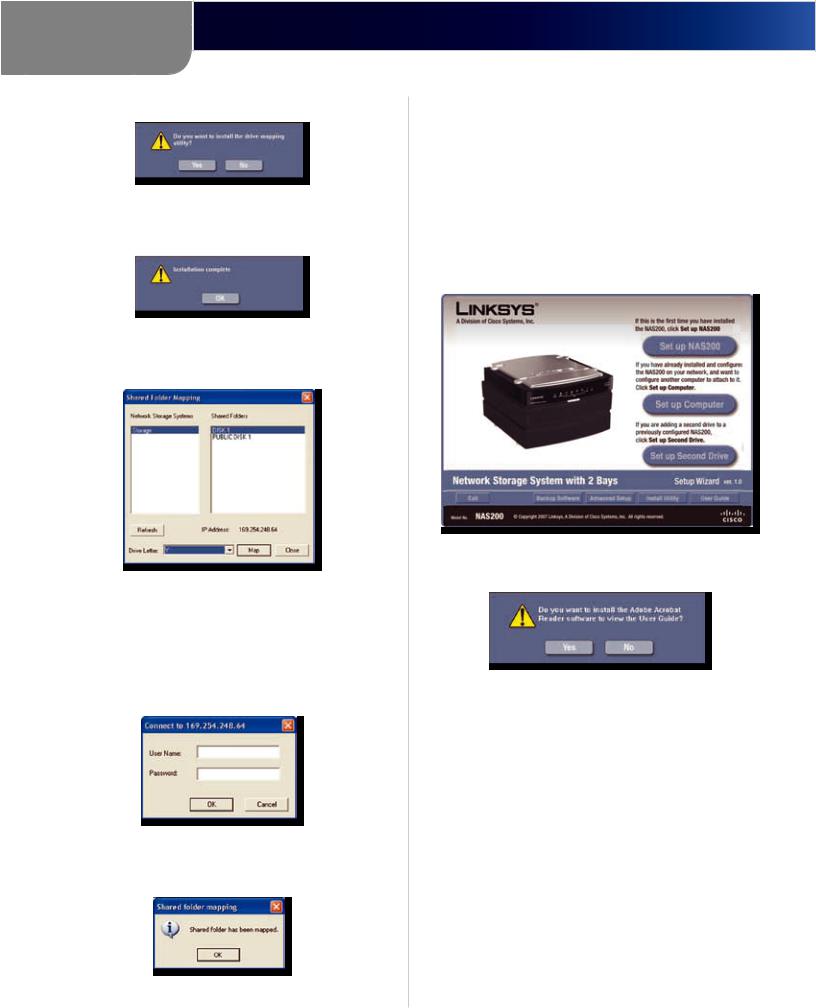
Chapter 2
Configuration Using the Setup Wizard
2. Click Yes.
Install Drive Mapping Utility
3.The Setup Wizard automatically installs the utility. Click OK.
Drive Mapping Utility Installed
4.On the Shared Folder Mapping screen, select the appropriate Network Storage System.
Map Network Drive
5.Select the appropriate shared folder. If you do not see the folder you want, click Refresh.
6.Keep the default drive letter, or select a different letter from the drop-down menu. Then click Map.
7.Enter your information in the User Name and Password fields. Click OK.
Login Screen
8.You are notified when the shared folder has been mapped. Click OK.
Shared Folder Mapped
9.The shared folder automatically opens in a separate window.
Repeat steps 5-8 to map additional network drives.
10.To exit the utility, click Close on the Shared Folder Mapping screen.
For more information about the utility, refer to“Chapter 4: Use”.
User Guide
Click this option to access the pdf of this User Guide.
User Guide
To install Adobe Reader, click Yes. To cancel, click No.
Adobe Reader
Network Storage System with 2 Bays |
10 |
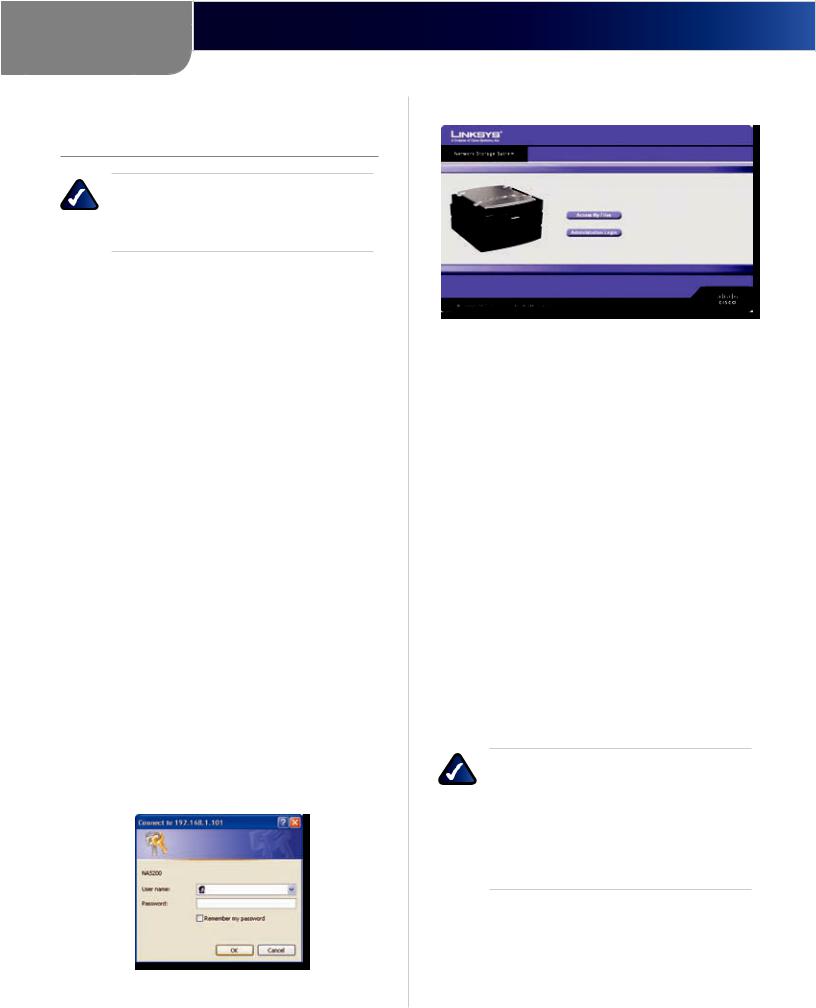
Chapter 3
Advanced Configuration
Chapter 3:
Advanced Configuration
NOTE:When first installing the Network Storage System, you should use the Setup Wizard on the Setup CD-ROM. If you want to configure advanced settings, use this chapter.
After setting up the Network Storage System with the Setup Wizard (located on the CD-ROM), it is ready for use. If you want to change its advanced settings, use the webbased utility. This chapter describes each web page of the utility and each page’s key functions. You can access the utility via a web browser on a computer connected to your network router.
On the homepage of the web-based utility, you have two options, Access My Files and Administration Login. Additional tabs will be available after you click one of the main options.
How to Access the Web-Based Utility
To access the Network Storage System from any computer using a web browser, follow these instructions:
1.Open your web browser.
2.In the Address field, enter http://<IP_address_of_ the_Network_Storage_System>. Press Enter.
If you do not know its IP address, then run the Setup Wizard. Click the Click Here to Start button. Then click Advanced Setup. Select the appropriate Network Storage System, and its IP address will be displayed. (For more information, refer to “Chapter 2: Configuration Using the Setup Wizard”.)
3.A login screen appears. (Non-Windows XP users will see a similar screen.) The first time you open the web-based utility, enter admin in the User name and Password fields. (The default user name and password is admin. You can set a new password for the admin user on the Access My Files > Personal Info screen.) Click
OK to continue.
Login Screen
The web-based utility appears.
Home Screen
Home
On the homepage of the web-based utility, you have two options:
Access My Files Click this option to access folders or change your password.
Administration Login Click this option to manage the Network Storage System through the web-based utility.
My Files > Files
To access folders or change your password:
1.Click Access My Files.
2.Enter your information in the User Name and Password fields.
3.Click OK.
The Files screen automatically appears. You have two options available, Files and Personal Info, in the My Files column. If the Download Manager feature has been enabled through the Administration > System Options screen and your login has Download Manager access, then the My Downloads option will also be displayed.
NOTE: The Download Manager feature lets you specify download tasks for the Network Storage System. The advantage is that the Network Storage System can run the download task separately, without using your computer. For example, if you order a movie online, then you can have the Network Storage System—instead of your computer—download the movie.
Network Storage System with 2 Bays |
11 |
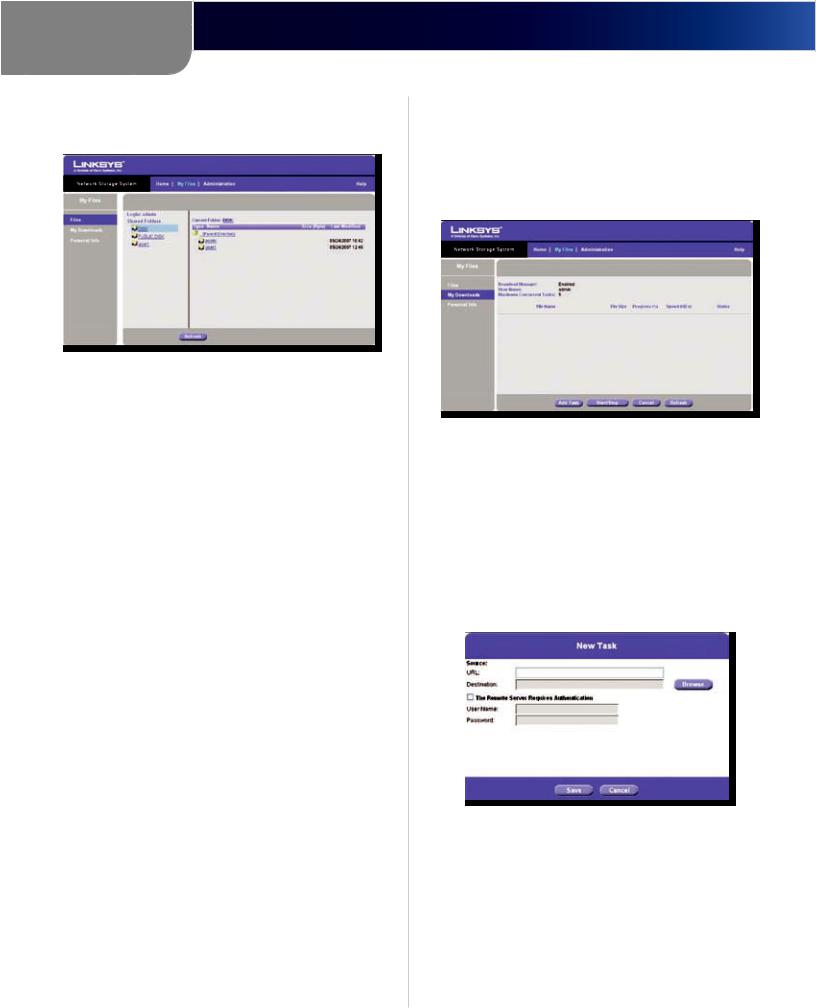
Chapter 3
Advanced Configuration
Login
The login you use to access your files is displayed.
My Files > Files
Shared Folders
The Files screen displays a list of shared folders that you can access, according to your user account. Within a shared folder, users with access to that shared folder can create other folders and files.
Public Folders These are shared folders accessible to all users. Disk 1 and Disk 2 are listed as PUBLIC DISK 1 (Public Data) and PUBLIC DISK 2 (Public Data).
Private Folders These are your personal folder and the shared folders associated with your login. (The administrator controls folder access using the
Administration > Shared Folders screen.)
USB Storage Devices All users have access to the devices connected to the Network Storage System.
Current Folder
The shared folder you are currently accessing is displayed. The sub-folders available to you are listed with the following information: Type, Name, Size, and Last Modified date and time.
Click the folder you want to access. To view a file, click the filename. To download a file, right-click the filename and select Save Target as...
Click Refresh for the most up-to-date information.
My Files > My Downloads
If the Download Manager feature has been enabled through the Administration > System Options screen and your login has Download Manager access, then the My Downloads screen will be available. Configure download tasks on this screen.
My Files > My Downloads
Download Manager The status of the Download Manager feature is displayed.
User Name Your login name is displayed.
Maximum Concurrent Tasks The maximum number of tasks that can run at the same time is displayed.
For each download task, the screen lists the File Name, File Size, Progress, Speed, and Status information.
Add Task Click this option to add a new download task. A new screen appears.
Create New Download Task
Source
•• URL Enter the URL of the FTP or HTTP URL.
•• Destination Click Browse. The Folders Browser screen appears.
Network Storage System with 2 Bays |
12 |

Chapter 3
Advanced Configuration
Folders Browser
––Current Folder Select the location of the shared folder that you want to specify as the current folder.
––New Folder To create a new folder, enter its name, and then click Create. Select the new folder from the list, and its path appears in the Current Folder field.
Click Apply to save the location. Click Close to exit this screen.
•• The Remote Server Requires Authentication If authentication is required to access the URL, select this option, and complete the following:
––User Name Enter the user name used to access the URL.
––Password Enter the password used to access the URL.
NOTE: For more information about authentication for the remote server, contact the administrator of the remote server.
Click Save to save the new download task, or click Cancel to clear your changes.
Start/Stop Select the appropriate download task, and then click Start/Stop to start or stop the selected task.
Cancel If you want to delete a download task, select it, and then click Cancel.
Refresh Click Refresh to update the on-screen status information.
My Files > Personal Info
Change your password on this screen.
My Files > Personal Info
User Name Your login name is displayed. Current Password Enter your current password. New Password Enter your new password.
Confirm New Password Enter your new password again.
Click Save to save your new password, or click Cancel to clear your change.
Administration > Status
To manage the Network Storage System:
1.Click Administration Login.
2.Enter your information in the User Name and Password fields.
3.Click OK.
The Status screen shows information about the Network Storage System.
Administration > Status
Network Storage System with 2 Bays |
13 |
